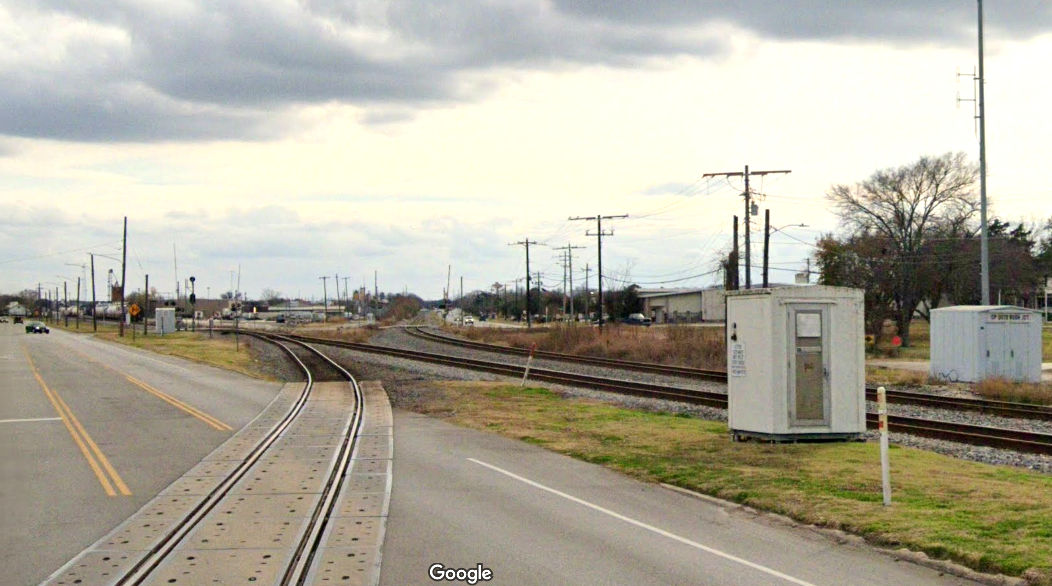Texas Railroad History - Tower 7 (College Station) and Tower 36 (Bryan)
Two Crossings of the International & Great Northern Railroad
and the Houston & Texas Central Railway Five Miles Apart
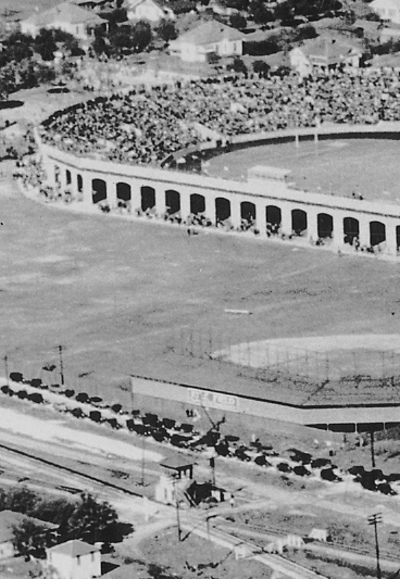
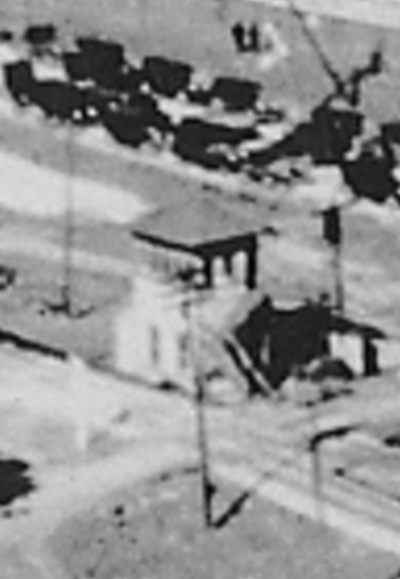
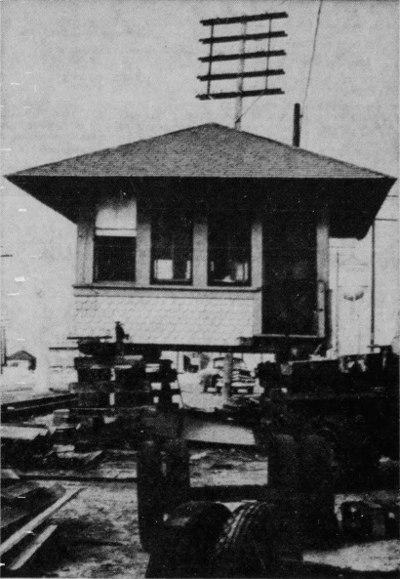
Above Left: This snippet
of a larger 1929 aerial photo looking northeast at Kyle Field in College Station
shows Tower 7 at the bottom of the image, just across from the baseball grandstands.
The football game at the Kyle Field stadium explains the cars parked adjacent to the tower.
Above Center: Magnification confirms a staircase on the south side of the
tower. (Henry Mayo collection)
Above Right: The
Bryan Eagle of December 19, 1957 reported
on the dismantling of Tower 36 at Bryan so that it could be moved by its new
owner, Luther Cobb, to his property in College Station to be used as a
residence. Cobb was a claims agent for Southern Pacific (SP). The photo shows the upper story operations room isolated from the base floor. Clearly visible
is the traditional Queen Anne
architecture "fish scale" pattern used between the floors of virtually every SP interlocking tower in Texas (e.g.
Tower 17 and many others.) (hat tip, Henry Mayo) Below Left:
This postcard of the International & Great Northern passenger depot in Bryan
shows a faint view of Tower 36 beside the tracks in the distance.
Below Right: The Tower 36
automatic interlocking cabin that replaced the manned tower in 1958 was still
standing forty years later (but has since been removed.) (Jim King photo c.1998)
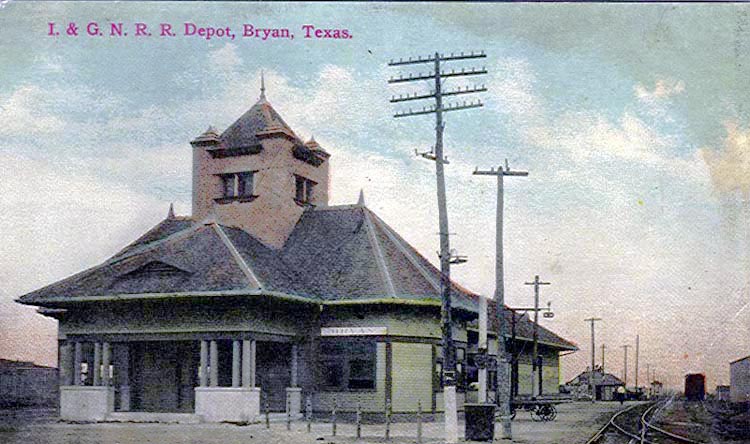
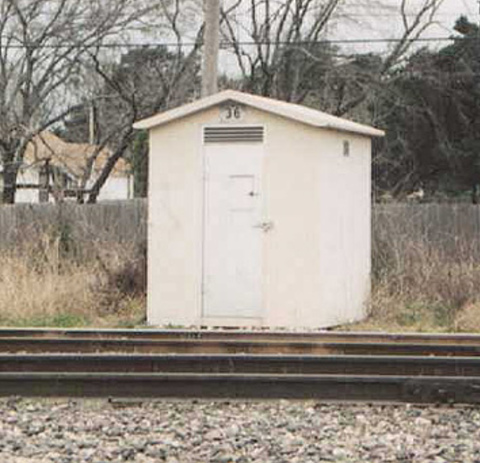
The town of Bryan was founded in 1859 by the Houston &
Texas Central (H&TC) Railway as it built north through the area. It was named
for William J. Bryan, the landowner who donated the property for a townsite. He
was a nephew of Texas' founding statesman Stephen F. Austin. Construction
stopped south of Bryan at the community of Millican during the
Civil War. In 1867, the railroad finally reached Bryan and continued building north, completing tracks to
Denison near the Red River in 1873. At Denison, the
H&TC connected with the Missouri, Kansas & Texas Railway (MK&T, but commonly
known as "the Katy".) The Katy had built south from Kansas and
Missouri through Indian
Territory and bridged the Red River into Texas. Soon, the Katy and the H&TC were
collaborating on single train passenger service between Houston and St. Louis. The railroads exchanged freight at
Denison, creating a major route for exporting Midwest grain commodities through
the port of Galveston. In the early 1880s, the H&TC was
acquired by Southern Pacific (SP).
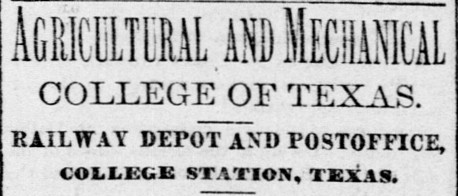 |
On
October 4, 1876, Texas Agricultural and Mechanical College (now Texas
A&M University) opened on 2,400 acres of land about five miles south of Bryan.
At least by 1878, the name College Station had been adopted for
the community, named for the railroad station adjacent to campus. As
there was literally nothing else in the vicinity and many Texans were
unfamiliar with the new school, the college ran advertisements in major
statewide newspapers periodically to announce upcoming semesters. The
college had no street address; it was simply "Railway Depot and Postoffice, College Station, Texas."
Left:
Galveston Daily News, August 10,
1880 |
The International & Great Northern (I&GN) Railroad had
been part of railroad magnate Jay Gould's vast collection of railroads since
1881, and he had named himself President of the I&GN. At the time,
it was the largest railroad in Texas. Upon his death in 1892,
his son George took over as President and began managing the I&GN and the rest
of the Gould empire. Like many other rail executives, George Gould preferred to do
new construction under a separate charter to isolate the main railroad from
any financial problems that might ensue. Thus, he chartered the Calvert, Waco and Brazos Valley
(CW&BV) Railroad to handle the construction of a new line he wanted to build, ostensibly
from the I&GN main line at Valley Junction north to
Waco and Fort Worth. Gould also
planned to extend this new line south from Valley Junction to
Houston but this was not reflected in the initial CW&BV charter. The charter was revised on
May 6, 1900 to make Bryan the southern terminus instead of Valley Junction, but
Gould quickly realized this would serve little purpose. From Bryan, a trackage
rights agreement with the H&TC would be needed to reach Houston, but there was
little possibility that a deal could be made as this would be against H&TC's
self-interest. The charter was revised again in December, 1900 to move the south
endpoint to Spring, just north of Houston on the
I&GN main line between Houston and Palestine.
Right: The CW&BV construction commenced in 1901
and went as far south as Bryan, but it quickly ran into problems with
the H&TC. An article under this
headline in the Navasota Daily Examiner
of September 3, 1901 discussed a restraining order the H&TC had obtained
against "the International" to prevent additional crossings of its
tracks (it was public knowledge that the CW&BV
was a "construction arm" of the I&GN.)
The H&TC objected to the entire enterprise because it would result in
the I&GN serving many communities already served by the H&TC, and
because their south endpoints would be the same: Houston.
The
CW&BV had already built across the H&TC at Bryan and had decided to
do so two more times, at College Station and
Navasota. The article spoke highly of the trackwork that had already
been accomplished, noting that the line between Bryan and College
Station "...is free from curve and nearly 2,000 feet shorter than the
Central..." The article also explained that the location
chosen by the I&GN for the College Station crossing was "...almost level, and
one at which Houston and Texas Central trains have stopped for a number
of years to make the sidings at the college for the meeting of trains."
The H&TC had no legal right to prevent the I&GN's construction. Its
claim was that Gould was building the line through the area simply to
harass the H&TC, a dubious theory which did not stand with the Court. I&GN claimed to have been trying to work with the H&TC
but to no avail, pointing out that it had "...suggested the building of
union depots at College and Navasota, and the Houston and Texas Central
absolutely refused to cooperate..." The restraining order was lifted and
in 1902, the I&GN formally took over the effort and finished the tracks through College Station and Navasota to the I&GN main line at
Spring. Whereas the I&GN tracks between Bryan and College Station were shorter
than the H&TC's, its route from College Station to Navasota was longer, swinging well west of the H&TC right-of-way,
closer to the Brazos River. |
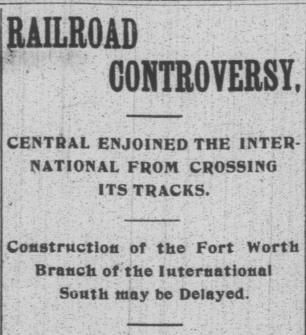 |
In the opposite direction, the I&GN built from Valley
Junction northwest to Waco (41 miles) in 1902, continuing 95 miles to Fort
Worth in 1903. This completed the I&GN's new Fort Worth Division between Fort
Worth and Spring. This was a reasonably direct route so it should have
positioned the I&GN to compete favorably for Fort Worth - Houston traffic
against SP, Santa Fe and the Katy. Instead, the route had major issues, as author
Wayne Cline described in his book
The
Texas Railroad ((c) Wayne Cline, 2015)...
...the Fort Worth Division was built
with "rapid-fire" techniques, which were not noted for producing safe and
durable results. By 1902 short trains were rocking slowly along the wavy tracks
of the new Fort Worth Division, and the following year found them creeping over
a new 45-mile branch between Navasota and Madisonville."
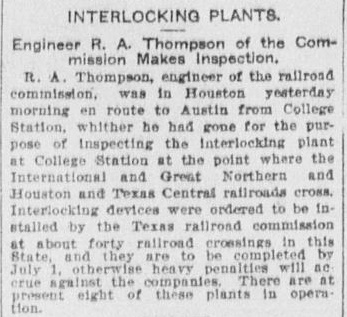 |
Through Bryan and College Station, the I&GN paralleled
the H&TC and crossed it twice at acute angles: on the south side of
College Station and near downtown Bryan. Interlocking plants were
planned and subsequently approved at both locations by the Railroad
Commission of Texas (RCT.) Internal SP records show that the planning
for the College Station interlocking occurred much earlier than might be
expected. An internal SP summary document for the anticipated
interlocking
is dated October 23, 1901, only eight days after the first
public hearing ever held by RCT
pertaining to the implementation of the new state law (effective three
months earlier on July 1) granting authority to govern modes
of crossing and safety requirements such as interlocking plants. RCT's
order on November
8, 1901 required railroads to implement swing gates as an
interim measure until RCT could publish rules and regulations governing
the design, installation and inspection of interlockers.
In May, 1902, RCT adopted formal rules
for
the process by which tower and interlocking plant designs would
be regulated and approved. At the end of 1902, RCT's Annual Report
included College in a list of priority locations to be
interlocked in 1903. By then, the consultation process between
RCT and the two railroads at College Station had been underway for many
months and the new plant was imminent. Tower 7 was commissioned for operation at
College Station on
February 21, 1903.
Left:
The Houston Daily Post
of February 22, 1903 reported RCT's approval of the new interlocker at College Station.
On the same day, the Bryan Eagle
published a news item quoting a story from the prior day's
Navasota Examiner
... "Charles Smith in charge of the
works here went to College Station today to put into operation the
interlocking switch plant recently installed there. The state railroad
commission is to be present at the test to pass officially on its
efficacy."
|
SP created an internal single-page form known as a D-205
Drawing for each interlocker at which it was a participating railroad. The form
provided a list of the interlocking function assignments and a specification of the share of recurring Operations and Maintenance (O&M)
expenses owed by each railroad. The form had the lengthy title
STATEMENT SHOWING
LEVERS, FUNCTIONS AND DIVISION OF EXPENSE AT INTERLOCKING PLANT.
The railroads sharing an interlocking tower would sign a contract allocating
various O&M responsibilities, designating how expenses would be divided and how
and when payments would be accomplished. Railroads were free to negotiate their own
arrangement for how they would share O&M
expenses, but most often they followed RCT's default rule to share on the basis of function count
ratios. Since every function in an interlocking plant could be attributed to one
of the railroads (or in some cases, both railroads, in which case each railroad
was credited with a half-function), the ratio of a railroad's function count
to the plant's total count became its function count ratio. Operating the tower and
performing maintenance activities were considered separate tasks. For most
manned towers, one railroad took the lead
for both, typically the railroad that designed and built the tower, and acquired
the interlocking plant.
The non-recurring cost of interlocking plants and
tower buildings was handled differently. For crossings that pre-dated the 1901
law, the railroads at the crossing shared the capital expenses evenly. For
crossings after June 30, 1901, the second railroad at the crossing, i.e. the one
that created it, was responsible for all of the capital expense. At least for
College Station, the I&GN tracks crossed after July 1, so the I&GN had to bear all
of the capital expenses. At the end of 1903, RCT
began publishing a comprehensive list of active interlockers within each annual
report. The first report identified Tower 7's interlocker as a mechanical plant
built by Union Switch & Signal Co. with 19 functions and 17 working levers.
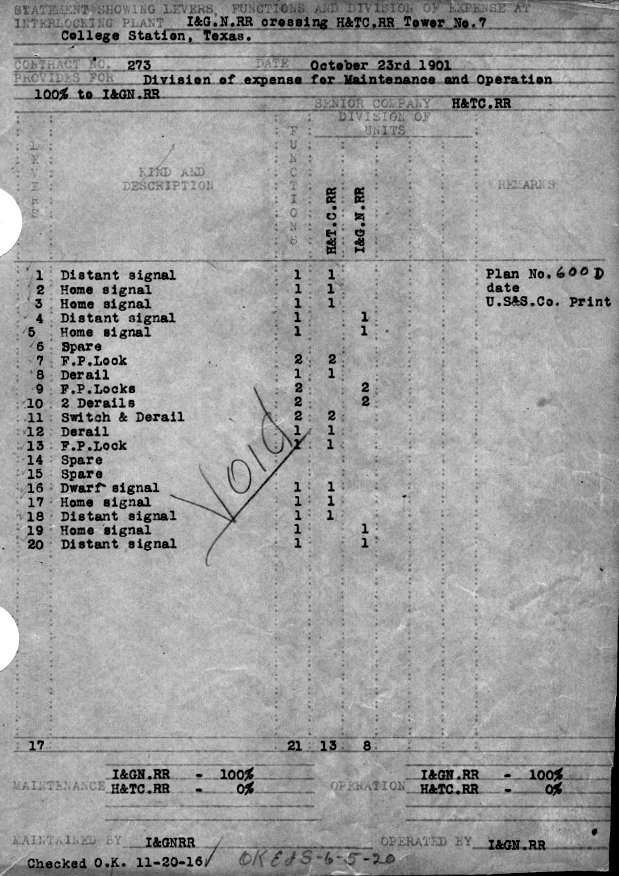
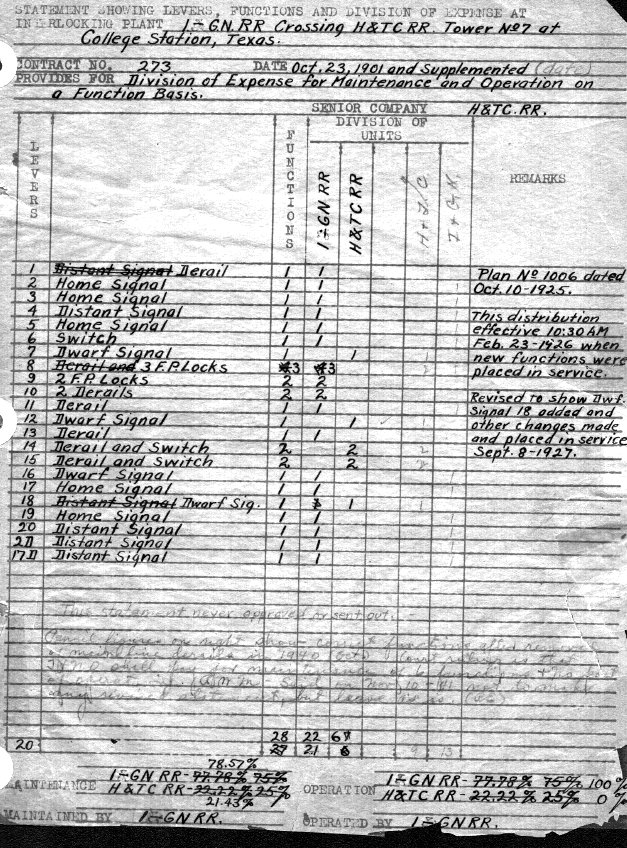
Above Left: SP's original
D-205 Drawing (Carl Codney collection) for Tower 7 is dated October 23, 1901. It
was very common for interlocking function changes to be handwritten on these
forms along with other explanatory notes, but this form shows almost no
handwriting at all. Yet, it has notations at the
bottom indicating it was "checked" by SP personnel in 1916 and again in 1920,
suggesting that it was, indeed, the bona fide Tower 7 document. It also shows that
despite 13 of the 21 interlocker functions being assigned to the H&TC, the I&GN
is listed as responsible for 100% of the O&M expenses. Even a simple 50 / 50
split would have been rational, so why would the I&GN pay 100%? The most likely
explanation is that since the railroads would be sharing two interlocking towers
five miles apart, the I&GN took the O&M expenses for Tower 7 and the H&TC took
the O&M expenses for Tower 36 at Bryan which opened on April 22, 1904. This
would simplify their accounting by eliminating the need to track the O&M
expenses closely for monthly billing purposes for each tower. Consistent with
such arrangement, RCT's records show the I&GN responsible for operating Tower 7
and the H&TC responsible for operating Tower 36. The discrepancy between the 21
functions listed and the 19 functions RCT reported in its interlocker summary table dated December 31, 1903 remains unexplained. Tower
7's reported function count varied over the years from a low of 16 (1904 - 1915)
to a high of 30 (1927 - 1930) but specific changes are undefined. After December
31, 1930, RCT no longer published a table of active interlockers annually.
Above Right: This handwritten
version (Carl Codney collection) of the same document retains the original 1901
date but appears to have been created 24 years later to address a revised
interlocker design plan dated October 10, 1925. Notes in the REMARKS column
explain that the new functions were placed in service four months later on
February 23, 1926, and that additional changes were made in September, 1927. Two
additional columns were added in pencil in what appears to be a draft of another
set of changes. A notation across the bottom, also written in pencil, reads...
"This statement never approved or sent out. Pencil
figures on right show correct functions after removal of mainline derails in
1940 (Oct.) Court ruling is that T&NO shall pay for maintenance of 6 functions &
no part of operation. A M M said on Nov 10 - 41 not to make any revised
statement, but leave as is. (A E)."
...referencing the
Texas & New Orleans (T&NO) Railroad, an SP subsidiary to which the H&TC had been
leased. The court case referenced has not been identified.
In contrast to Tower 7,
Tower 36 at Bryan had a much smaller reported function count: ten, from 1903
through 1926. The count rose to 16 in 1927 and was unchanged after that. Like
Tower 7, Tower 36 was a mechanical interlocking plant, but RCT records note that
that the plant was "installed by" the H&TC whereas at Tower 7, the
plant manufacturer (Union Switch & Signal Co.) had performed the installation. The D-205 drawing for
Tower 36 has not been located so the precise definition of the functions remains undetermined. Tower 36 was substantially busier than Tower 7;
information provided by RCT in 1906 showed an average of 45 movements per day
past Tower 36 compared to only 23 at Tower 7.
In 1927, SP began
consolidating its Texas and Louisiana railroads into the Texas & New Orleans
(T&NO) Railroad, a long time SP subsidiary operating mostly in
Houston, east
Texas and Louisiana. SP leased the H&TC to the T&NO at that time and then fully merged the
H&TC into the T&NO in 1934. The T&NO was dissolved in 1961 and all of its assets
were merged directly into SP.
Whereas the H&TC had remained within the SP
railroad family since the 1880s, the I&GN had experienced a much more difficult path to stability. It
went into receivership in 1908,
partly from economic conditions and partly from financial miscalculations made
by George Gould pertaining to railroad investments elsewhere in the U.S. Gould
issued a statement blaming the receivership on orders issued by RCT mandating large expenditures to improve the I&GN's infrastructure
and service.
RCT stuck to its order, though it was roundly criticized throughout the railroad
industry. While other railroads were ordered to make similar improvements, RCT
rightfully had very serious concerns about the I&GN. The tracks through
Bryan and College Station were part of I&GN's Fort Worth Division, the newest
track construction in its network. Though it was new and accounted for only a
quarter of the company's mileage, the Fort Worth Division was the primary culprit
in the I&GN's difficulties. Author Wayne Cline explains that after George Gould had taken control in the wake of
his father's death in late 1892...
"...the International and Great
Northern had compiled a reasonably acceptable safety record, but it went rapidly
downhill shortly after the Fort Worth Division was constructed. In 1904,
casualties suddenly soared when 139 workers and passengers were injured --
almost twice the average for the previous ten years. ...[in 1908] Commission records
showed that 99 wrecks had occurred on the I&GN since the summer of 1907, and 41
of them occurred on the newly laid track of the Fort Worth Division."
Emerging from bankruptcy in 1911, a new I&GN company
was organized to take over the assets and operations of the old company, with
the Gould family still in charge. In early 1914, the I&GN again returned to
receivership, this time for several years which included the period under the U.
S. Railroad Administration during World War I. Another new company with a
slightly different name, the International - Great Northern (I-GN) was formed in
1922 to acquire the I&GN out of foreclosure, at which point the Gould family
connection to the I&GN ended forever.
The I-GN's financial
reorganization coupled with its service to many of the major cities in Texas and
its thousand miles of track made it an attractive
target for acquisition. Missouri Pacific (MP) had gained its own independence from the Gould family in 1917
and wanted to buy the I-GN to re-enter the Texas market ("re-enter" because
under Gould's command, MP had leased the Katy in 1880 to gain a foothold in
Texas, but the lease had been abrogated by the Texas Supreme Court in 1890.)
MP's proposed purchase of the I-GN was nixed by the Interstate Commerce
Commission (ICC). Going to Plan B, MP helped the New Orleans, Texas & Mexico
(NOT&M) Railway buy the I-GN.
The NOT&M was originally among a collection of
ostensibly independent railroads
operating between New Orleans and Brownsville sharing the moniker Gulf Coast
Lines (GCL.) The railroads had been managed collectively by executives of
the St. Louis & San Francisco ("Frisco") Railway and a syndicate backed by the
St. Louis Trust Co. The Frisco's
receivership in 1914 resulted in the bankruptcy judge choosing the NOT&M to
become the corporate parent for all of the GCL railroads through common
ownership under the St. Louis Trust Co. syndicate. The
ICC approved NOT&M's purchase of the I-GN in 1924 and then allowed MP to buy the NOT&M on
January 1, 1925. This gave MP the I-GN plus all of the NOT&M railroads -- a
sudden and massive presence for MP in Texas. In 1933, MP went into a lengthy
receivership which likewise compelled a receivership for its I-GN subsidiary.
Operating for more than two decades under court supervision, MP finally emerged from bankruptcy in 1956. MP dissolved the I-GN
at that time and integrated
its operations under the MP name.

Above: Oriented with College
Station to the right, this image snippet from a 1926 T&NO track chart of Bryan
(Carl Codney collection) uses a dark square to represent the location of Tower
36 east of the I-GN / H&TC crossing diamond. The other two dark objects are SP
depots. The freight depot is between the Front House track and the Back House
track. The passenger depot is beside (east of) the main line. The chart shows
an "I&GN Tr." (transfer) track south of the diamond. The H&TC had been in Bryan
for three decades by the time the I&GN arrived, so it is not surprising that
many businesses had built along the H&TC main line to gain the advantage of rail
service. The I&GN did open some new areas for service in town, but it was not
positioned to overcome SP's advantage for local freight traffic.
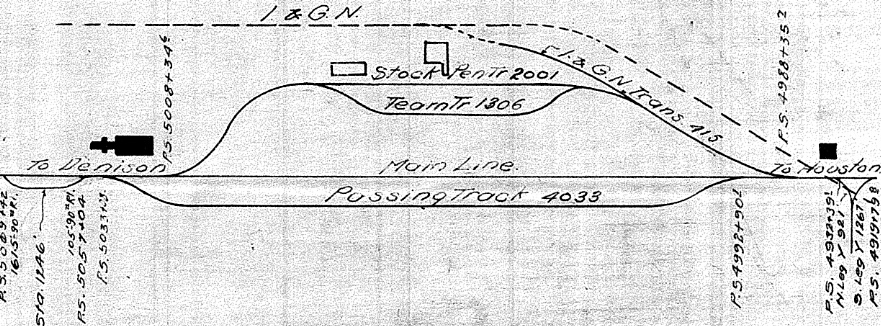 |
Left: This
1926 T&NO track chart of College Station (Carl Codney collection) uses a
black square to represent Tower 7 at the H&TC / I-GN crossing. Bryan is
to the left, Navasota to the right. The H&TC passenger depot is the dark
object to the left. A wye track and the I-GN transfer track both
intersected the main line near the crossing diamond. Switch, derail and
signal controls for these tracks may have been the reason that the Tower
7 interlocker had more functions than Tower 36. |
A 1952 T&NO Employee Timetable shows Tower 7 and 36
both having "continuous" office hours, i.e. they were manned 24 / 7. This may
seem obvious for a manned tower, but in some places (e.g.
Tower 33), towers had begun to close
for specified periods on a regular schedule (e.g. lunch hour, overnight, Sundays were
common.) Railroads began to reduce staffing further to save money, and some towers
opened only for a basic "day shift", leaving the signals lined for
the busier track at all other times. A telephone was accessible nearby if a train on
the other line needed to call an operator at home to come in and change the
signals. This approach worked to reduce staffing costs, but it was only
effective at select locations where one of the tracks had limited traffic.
Neither Bryan nor College Station qualified.
Right:
This paragraph appeared in T&NO's Employee Timetable supplement
Dallas and Austin Divisions Special
Instructions No. 5 effective December 6, 1959. By this date,
both towers had been converted to automatic interlockings.
SP records show that on June 14,
1956, a plan for an automatic interlocker to replace Tower 7 was created.
Documentation shows that the plan was revised on September 26, 1960 and the
revised plan became effective on November 8, 1960. It is undetermined precisely
when the Tower 7 building was removed, and its fate has not been
determined. The Tower 36 interlocker was converted to an automatic system in
1957 and the tower structure was relocated on
January 5, 1958. In 1965, MP and SP agreed to share the SP line south from College Station to Navasota. This allowed
the former I-GN line to be abandoned between Tower 7 and Tower 9,
with the tracks through College Station and Bryan operated jointly by
both railroads. Union Pacific (UP) acquired MP in 1982 and merged with
SP in 1996. All of these tracks are now owned by UP. |

 |
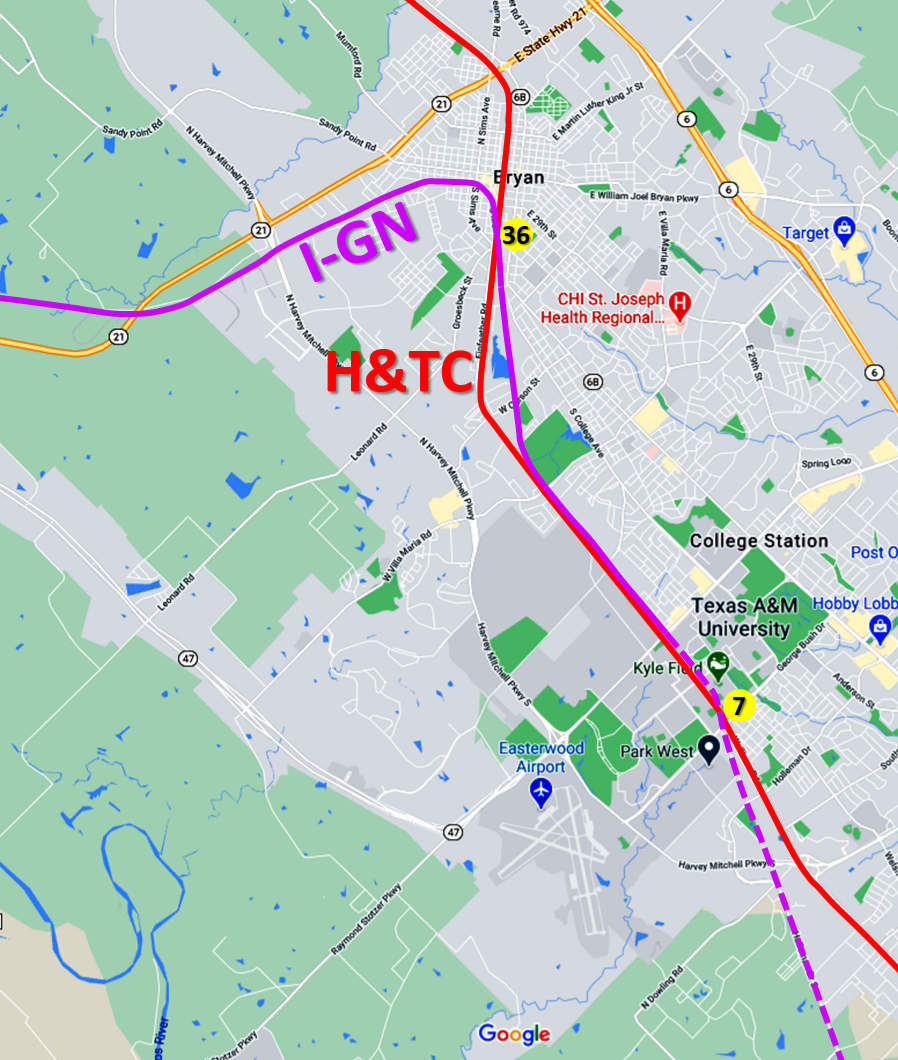 |
Left: The H&TC line
went northwest out of Bryan and continued to Hearne while the I-GN swung
due west out of Bryan and then curved north to Valley Junction, crossing
another SP line at Tatsie en route. To the
south, both lines went to Navasota, but the I-GN tracks were removed in
1965.
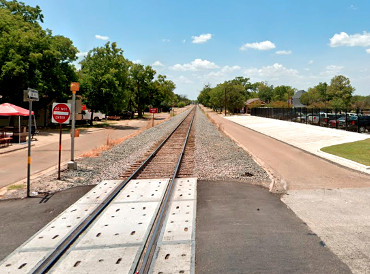
Above: ex I-GN tracks
on 27th St., Bryan (Google SV)
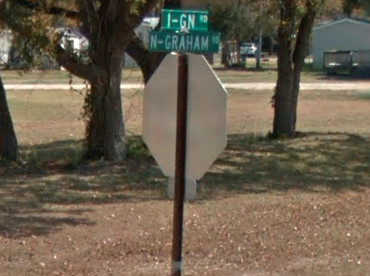
Above: I-GN Rd.,
College Station (Google Street View)
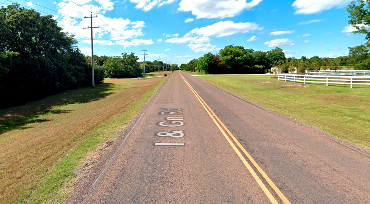
Above: Google Street
View projects the "I-Gn Rd" name onto the pavement in this straight
stretch of former grade south of College Station. The I-GN right-of-way
was probably one hundred feet wide. |
Below:
Although tracks exist in all four directions, Google Street View from December, 2019 shows that there is no longer a
crossing at the site of Tower 36. Looking south down the former SP right-of-way,
the track coming north from College Station curves to the northwest to join the
former MP right-of-way instead of crossing over the MP as it previously did. The track on the former MP
right-of-way coming north (where railcars sit at left) from College Station continues straight across as it always did, but a switch has been added to
connect to the track on the former SP right-of-way to Hearne.
